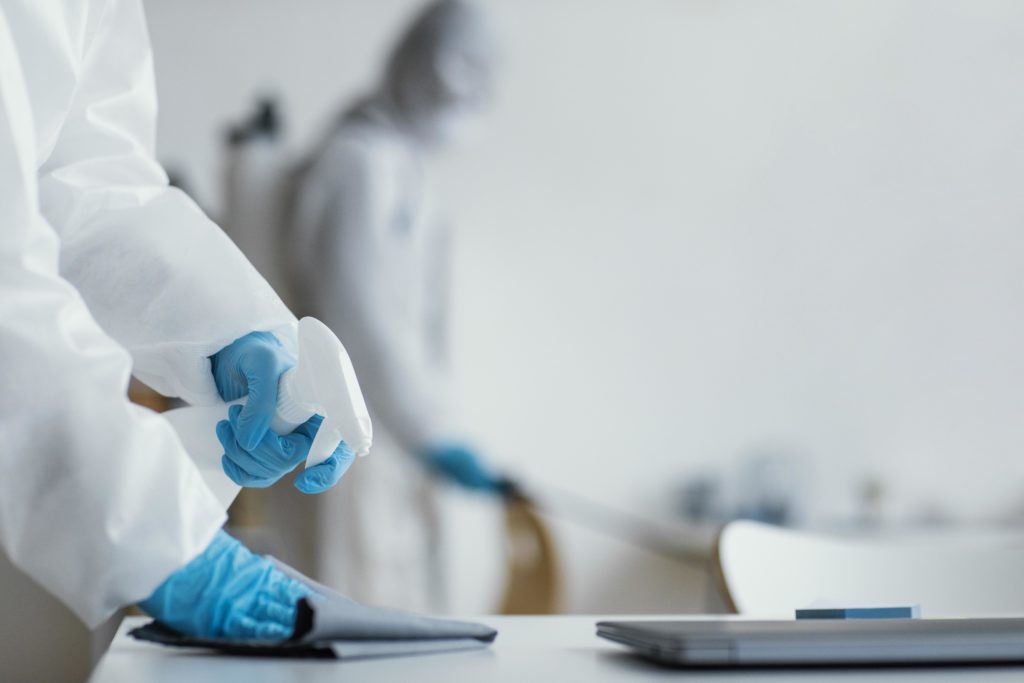Your workplace COVID-19 protocol: The difference between cleaning and disinfecting
As a result of COVID-19, maintaining safe workplaces has never been more critical. One critical part of maintaining safe workspaces is cleaning and disinfecting the facility. But, with so much information available, owners and facility managers can be confused about the difference between cleaning, disinfecting — and which one helps keep workplaces safer from COVID-19.
Alone, cleaning is not enough to decontaminate your workspaces of COVID-19 and other viruses, but it’s an essential first step for both household and commercial decontamination, as recommended by the Centers for Disease Control. Cleaning removes dirt and build-up from office surfaces and is a crucial first step to disinfect surfaces.
Disinfecting breaks down bacteria, viruses, and the COVID-19 virus. Your employees or staff could be spreading their illness for several days before they show symptoms.

What does the CDC recommend for commercial COVID-19 disinfection services?
According to the CDC, it’s vital to ensure that any disinfectants used for commercial COVID-19 decontamination are either applied in combination with cleaning products or confirmed to include their cleaning agents.
Workplaces should develop consistent decontamination protocols that ensure they’re:
- Always using disinfectants and other cleaning products that are EPA-certified for COVID-19 decontamination.
- Cleaning and disinfecting high-traffic areas and surfaces at least once a day.
- Increasing frequency of the decontamination process if the local community has high COVID-19 transmission or low vaccination rates.
What are the high-traffic areas that COVID-19 disinfection services should pay attention to in the workplace?
High-traffic and high-touch areas have an increased risk for contamination. Make sure these work surfaces are cleaning and disinfecting at least once a day:
- Door handles
- Tablets
- Touch screens
- Computers
- Kiosks
- Keyboards
- Shared office supplies (pens, dry erase markers, staplers, tape dispensers)
- Desks
- Conference or meeting room tables and chairs
- Break room surfaces (kitchen counters, coffee makers, fridge, water dispensers)
Additionally, certain types of surfaces and materials like upholstered furniture can be cleaned using normal wipe down methods, but need disinfectants that the EPA has certified for use on soft surfaces.

How should vaccinations affect your COVID-19 disinfection plans?
While vaccinations make us all safer from developing severe COVID-19 cases, workplace decontamination is still important. Increasing vaccination rates, even within the office staff, aren’t a guarantee or a reason to abandon workplace safety protocols.
Many communities will likely not reach the levels needed for herd or population immunity for some time, and immunocompromised people on your staff may not be able to receive vaccinations. And as COVID-19 transmissions continue to occur, the appearance of highly-infectious mutations like the Delta variant means that commercial decontamination is still needed to maintain workplace safety.
What can you expect from professional COVID-19 disinfection services?
Professional commercial disinfection services for COVID-19 can include:
- General disinfection and sanitation services
- Soft surface decontamination
- Healthcare facility sterilization services
- Post-exposure deep cleaning and disinfecting for COVID-19
- Using hospital grade disinfectants
COVID disinfecting service cost can vary. Make sure to get a quote from a trained and prepared service provider.
Contact JK Janitorial for commercial-grade COVID 19 disinfection services you and your business can rely on.
As in-person work restarts in many areas, it’s critical that building owners or facility managers understand the difference between cleaning and disinfecting as they plan their ongoing COVID-19 protocols. Let the independently owned and operated JK Janitorial apply expert, certified COVID-19 decontamination services to help keep your staff healthy and safe.


